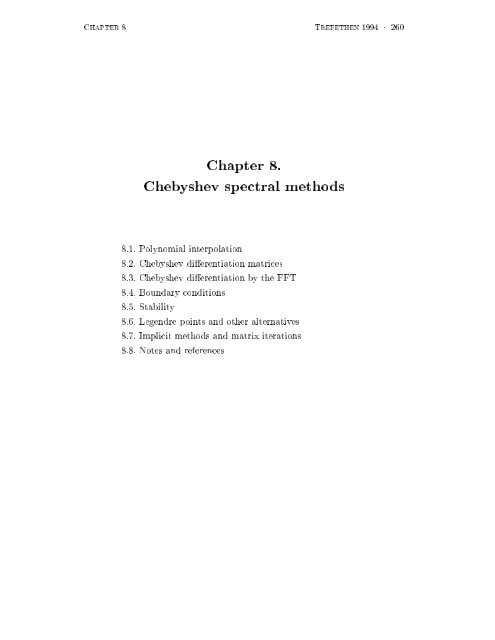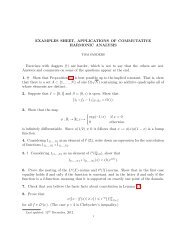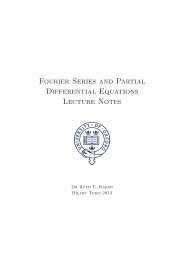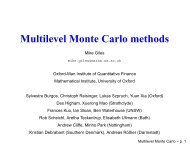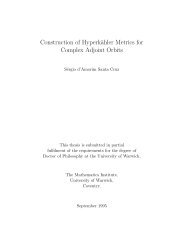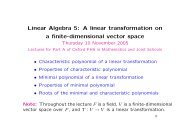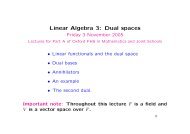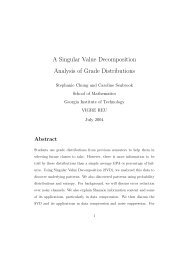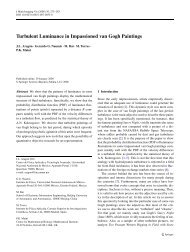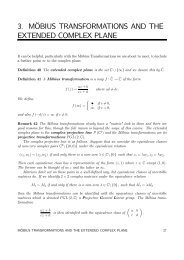Chapter 8. Chebyshev spectral methods
Chapter 8. Chebyshev spectral methods
Chapter 8. Chebyshev spectral methods
You also want an ePaper? Increase the reach of your titles
YUMPU automatically turns print PDFs into web optimized ePapers that Google loves.
CHAPTER 8 TREFETHEN 1994 260<br />
<strong>Chapter</strong> <strong>8.</strong><br />
<strong>Chebyshev</strong> <strong>spectral</strong> <strong>methods</strong><br />
<strong>8.</strong>1. Polynomial interpolation<br />
<strong>8.</strong>2. <strong>Chebyshev</strong> di erentiation matrices<br />
<strong>8.</strong>3. <strong>Chebyshev</strong> di erentiation by the FFT<br />
<strong>8.</strong>4. Boundary conditions<br />
<strong>8.</strong>5. Stability<br />
<strong>8.</strong>6. Legendre points and other alternatives<br />
<strong>8.</strong>7. Implicit <strong>methods</strong> and matrix iterations<br />
<strong>8.</strong><strong>8.</strong> Notes and references
CHAPTER 8 TREFETHEN 1994 261<br />
This chapter discusses <strong>spectral</strong> <strong>methods</strong> for domains with boundaries.<br />
The e ect of boundaries in <strong>spectral</strong> calculations is great, for they often introduce<br />
stability conditions that are both highly restrictive and di cult to<br />
analyze. Thus for a rst-order partial di erential equation solved on an Npoint<br />
spatial grid by an explicit time-integration formula, a <strong>spectral</strong> method<br />
typically requires k = O(N ;2 ) for stability, in contrast to k = O(N ;1 ) for -<br />
nite di erences. For a second-order equation the disparity worsens to O(N ;4 )<br />
vs. O(N ;2 ). To make matters worse, the matrices involved are usually nonnormal,<br />
and often very far from normal, so they are di cult to analyze as well<br />
as troublesome in practice.<br />
Spectral <strong>methods</strong> on bounded domains typically employ grids consisting<br />
of zeros or extrema of <strong>Chebyshev</strong> polynomials (\<strong>Chebyshev</strong> points"), zeros or<br />
extrema of Legendre polynomials (\Legendre points"), or some other set of<br />
points related to a family or orthogonal polynomials. <strong>Chebyshev</strong> grids have<br />
the advantage that the FFT is available for an O(N logN) implementation<br />
of the di erentiation process, and they also have slight advantages connected<br />
their ability to approximate functions. Legendre grids have various theoretical<br />
and practical advantages because of their connection with Gauss quadrature.<br />
At thispoint one cannot say whichchoice will win in the long run, but in this<br />
book, in keeping with out emphasis on Fourier analysis, most of the discussion<br />
is of <strong>Chebyshev</strong> grids.<br />
Since explicit <strong>spectral</strong> <strong>methods</strong> are sometimes troublesome, implicit <strong>spectral</strong><br />
calculations are increasingly popular. Spectral di erentiation matrices are<br />
dense and ill-conditioned, however, so solving the associated systems of equations<br />
is not a trivial matter, even in one space dimension. Currently popular<br />
<strong>methods</strong> for solving these systems include preconditioned iterative <strong>methods</strong><br />
and multigrid <strong>methods</strong>. These techniques are discussed brie y in x<strong>8.</strong>7.
<strong>8.</strong>1. POLYNOMIAL INTERPOLATION TREFETHEN 1994 262<br />
<strong>8.</strong>1. Polynomial interpolation<br />
Spectral <strong>methods</strong> arise from the fundamental problem of approximation<br />
of a function by interpolation on an interval. Multidimensional domains of a<br />
rectilinear shape are treated as products of simple intervals, and more complicated<br />
geometries are sometimes divided into rectilinear pieces.* In this section,<br />
therefore, we restrict our attention to the fundamental interval [;11]. The<br />
question to be considered is, what kinds of interpolants, in what sets of points,<br />
are likely to be e ective?<br />
Let N 1 be an integer, even or odd, and let x 0:::x N or sometimes<br />
x 1 :::x N be a set of distinct points in [;11]. For de niteness let the numbering<br />
be in reverse order:<br />
1 x 0 >x 1 > >x N;1 >x N ;1: (8:1:1)<br />
The following are some grids that are often considered:<br />
Equispaced points: xj =1; 2j<br />
N<br />
(0 j N)<br />
(j ;1=2)<br />
<strong>Chebyshev</strong> zero points: xj =cos<br />
N<br />
(1 j N)<br />
<strong>Chebyshev</strong> extreme points: xj =cos j<br />
N<br />
(0 j N)<br />
Legendre zero points: x j = j th zero of P N (1 j N)<br />
Legendre extreme points: x j = j th extremum of P N (0 j N)<br />
where P N is the Legendre polynomial of degree N. <strong>Chebyshev</strong> zeros and extreme<br />
points can also be described as zeros and extrema of <strong>Chebyshev</strong> polynomials<br />
T N (more on these in x<strong>8.</strong>3). <strong>Chebyshev</strong> and Legendre zero points are also<br />
called Gauss-<strong>Chebyshev</strong> and Gauss-Legendre points, respectively, and <strong>Chebyshev</strong><br />
and Legendre extreme points are also called Gauss-Lobatto-<strong>Chebyshev</strong><br />
and Gauss-Lobatto-Legendre points, respectively. (These names originate in<br />
the eld of numerical quadrature.)<br />
*Such subdivision <strong>methods</strong> have beendeveloped independently by I. Babushka and colleagues for<br />
structures problems, who call them \p" nite element <strong>methods</strong>, and byA.Patera and colleagues<br />
for uids problems, who call them <strong>spectral</strong> element <strong>methods</strong>.
<strong>8.</strong>1. POLYNOMIAL INTERPOLATION TREFETHEN 1994 263<br />
It is easy to remember how <strong>Chebyshev</strong> points are de ned: they are the<br />
projections onto the interval [;11] of equally-spaced points (roots of unity)<br />
along the unit circle jzj = 1 in the complex plane:<br />
Figure <strong>8.</strong>1.1. <strong>Chebyshev</strong> extreme points (N =8).<br />
To the eye, Legendre points look much the same, although there is no<br />
elementary geometrical de nition. Figure <strong>8.</strong>1.2 illustrates the similarity:<br />
Figure <strong>8.</strong>1.2. Legendre vs. <strong>Chebyshev</strong> zeros.<br />
As N !1, equispaced points are distributed with density<br />
(x)= N<br />
2<br />
(a) N =5<br />
(b) N =25<br />
Equally spaced (8:1:2)
<strong>8.</strong>1. POLYNOMIAL INTERPOLATION TREFETHEN 1994 264<br />
and Legendre or <strong>Chebyshev</strong> points|either zeros or extrema|have density<br />
(x)=<br />
N<br />
p 1;x 2<br />
Legendre, <strong>Chebyshev</strong>: (8:1:3)<br />
Indeed, the density function (<strong>8.</strong>1.3) applies to point sets associated with any<br />
Jacobi polynomials, of which Legendre and <strong>Chebyshev</strong> polynomials are special<br />
cases.<br />
Why is it a good idea to base <strong>spectral</strong> <strong>methods</strong> upon <strong>Chebyshev</strong>, Legendre,<br />
and other irregular grids? We shall answer this question by addressing<br />
a second, more fundamental question: why is it a good idea to interpolate a<br />
function f(x) de ned on [;11] by a polynomial p N (x) rather than a trigonometric<br />
polynomial, and why is it a good idea to use <strong>Chebyshev</strong> or Legendre<br />
points rather than equally spaced points?<br />
[The remainder of this section is just a sketch::: details to be supplied later.]<br />
PHENOMENA<br />
Trigonometric interpolation in equispaced points su ers from the Gibbs<br />
phenomenon, due to Michelson and Gibbs at the turn of the twentieth century.<br />
kf ; p N k = O(1) as N !1, even if f is analytic. One can try to get<br />
around the Gibbs phenomenon by various tricks such as doubling the domain<br />
and re ecting, but the price is high.<br />
Polynomial interpolation in equally spaced points su ers from the Runge<br />
phenomenon, due to Meray and Runge (Figure <strong>8.</strong>1.3). kf ;p N k = O(2 N )|<br />
much worse!<br />
Polynomial interpolation in Legendre or <strong>Chebyshev</strong> points: kf ; p N k =<br />
O(constant ;N ) if f is analytic (for some constant greater than 1). Even if<br />
f is quite rough the errors will still go to zero provided f is, say, Lipschitz<br />
continuous.
<strong>8.</strong>1. POLYNOMIAL INTERPOLATION TREFETHEN 1994 265<br />
Figure <strong>8.</strong>1.3. The Runge phenomenon.
<strong>8.</strong>1. POLYNOMIAL INTERPOLATION TREFETHEN 1994 266<br />
FIRST EXPLANATION|EQUIPOTENTIAL CURVES<br />
Think of the limiting point distribution (x), above, as a charge density<br />
distribution a charge at position x is associated with a potential log jz ; xj.<br />
Look at the equipotential curves of the resulting potential function (z)=<br />
R 1;1 (x)logjz ;xjdx.<br />
Theorem <strong>8.</strong>1.<br />
CONVERGENCE OF POLYNOMIAL INTERPOLANTS<br />
In general, kf ; p N k!0 as N !1 in the largest region bounded by an<br />
equipotential curve in which f is analytic. In particular:<br />
For <strong>Chebyshev</strong> or Legendre points, or any other type of Gauss-Jacobi points,<br />
convergence is guaranteed if f is analytic on [;11].<br />
For equally spaced points, convergence is guaranteed if f is analytic in a<br />
particular lens-shaped region containing (;11) (Figure <strong>8.</strong>1.4).<br />
Figure <strong>8.</strong>1.4. Equipotential curves.
<strong>8.</strong>1. POLYNOMIAL INTERPOLATION TREFETHEN 1994 267<br />
SECOND EXPLANATION|LEBESGUE CONSTANTS<br />
De nition of Lebesgue constant:<br />
N = kI Nk 1<br />
where I N is the interpolation operator I N : f 7! p N . A small Lebesgue constant<br />
means that the interpolation process is not much worse than best approximation:<br />
kf ;p N k ( N +1)kf ;p N k (8:1:1)<br />
where p N is the best (minimax, equiripple) approximation.<br />
Theorem <strong>8.</strong>2.<br />
LEBESGUE CONSTANTS<br />
Equispaced points: N 2N =eN log N.<br />
p<br />
Legendre points: N const N.<br />
<strong>Chebyshev</strong> points: N const log N.<br />
THIRD EXPLANATION|NUMBER OF POINTS PER WAVELENGTH<br />
Consider approximation of, say, f N (x) = cos Nx as N !1. Thus f N<br />
changes but the number of points per wavelength remains constant. Will the<br />
error kf N ; p N k go to zero? The answer to this question tells us something<br />
about the ability ofvarious kinds of <strong>spectral</strong> <strong>methods</strong> to resolve data.<br />
Theorem <strong>8.</strong>3.<br />
POINTS PER WAVELENGTH<br />
Equispaced points: convergence if there are at least 6 points per wavelength.<br />
<strong>Chebyshev</strong> points: convergence if there are at least points per wavelength<br />
on average.<br />
We have to say \on average" because the grid is nonuniform. In fact, it<br />
is =2 times less dense in the middle than the equally spaced grid with the<br />
same number of points N (see (<strong>8.</strong>1.2) and (<strong>8.</strong>1.3)). Thus the second part of<br />
the theorem says that we need at least 2 points per wavelength in the center<br />
of the grid|the familiar Nyquist limit. See Figure <strong>8.</strong>1.5. The rst part of<br />
the theorem is mathematically valid, but of little value in practice because of<br />
rounding errors.
<strong>8.</strong>2. CHEBYSHEV DIFFERENTIATION MATRICES TREFETHEN 1994 268<br />
(a) Equally spaced points<br />
(b) <strong>Chebyshev</strong> points<br />
Figure <strong>8.</strong>1.5. Error as a function of N in interpolation of cos Nx,<br />
with ,hencethe number of points per wavelength, held xed.
<strong>8.</strong>2. CHEBYSHEV DIFFERENTIATION MATRICES TREFETHEN 1994 269<br />
<strong>8.</strong>2. <strong>Chebyshev</strong> di erentiation matrices<br />
[Just a sketch]<br />
From now on \<strong>Chebyshev</strong> points" means <strong>Chebyshev</strong> extreme points.<br />
Multiplication by the rst-order <strong>Chebyshev</strong> di erentiation matrix DN transforms a vector of data at the <strong>Chebyshev</strong> points into approximate derivatives<br />
at those points:<br />
2 3 2 3<br />
v0 w0 D N<br />
6<br />
4<br />
.<br />
v N<br />
7<br />
5 =<br />
6<br />
4<br />
.<br />
w N<br />
As usual, the implicit de nition of D N is as follows:<br />
CHEBYSHEV SPECTRAL DIFFERENTIATION BY POLYNOMIAL INTERPOLA-<br />
TION.<br />
(1) Interpolate v by a polynomial q(x)=q N (x)<br />
(2) Di erentiate the interpolant atthe grid points x j :<br />
7<br />
5 :<br />
w j =(D Nv) j = q 0 (x j): (8:2:1)<br />
Higher-order di erentiation matrices are de ned analogously. From this<br />
de nition it is easy to work out the entries of D N in special cases. For N =1:<br />
For N =2:<br />
x =<br />
2<br />
3<br />
7<br />
x =<br />
6<br />
4 1<br />
5 D1 =<br />
;1<br />
2<br />
6<br />
4<br />
1<br />
3<br />
7<br />
0<br />
7<br />
5<br />
;1<br />
D2 =<br />
2<br />
6<br />
4<br />
2 1<br />
6 2 ;<br />
4<br />
1 2<br />
1<br />
2 ; 1 3<br />
7<br />
5:<br />
2<br />
3 2 ;2 1 2<br />
3<br />
7<br />
1<br />
2 0 ; 1 2<br />
; 1 2 2 ; 3 7<br />
5<br />
2<br />
:
<strong>8.</strong>2. CHEBYSHEV DIFFERENTIATION MATRICES TREFETHEN 1994 270<br />
For N =3:<br />
x =<br />
2<br />
6<br />
4<br />
1<br />
1 2<br />
; 1 2<br />
3<br />
7<br />
5<br />
D 3 =<br />
2<br />
6<br />
4<br />
19 6 ;4 4 3 ; 1 2<br />
1 ; 1 3 ;1 1 3<br />
; 1 3 1 1 3 ;1<br />
1 ;1<br />
2 ; 4 3 4 ; 19<br />
6<br />
These three examples illustrate an important fact, mentioned in the introduction<br />
to this chapter: <strong>Chebyshev</strong> <strong>spectral</strong> di erentiation matrices are in general<br />
not symmetric or skew-symmetric. A more general statement is that they are<br />
not normal.* This is why stability analysis is di cult for <strong>spectral</strong> <strong>methods</strong>.<br />
The reason they are not normal is that unlike nitedi erence di erentiation,<br />
<strong>spectral</strong> di erentiation is not a translation-invariant process, but depends instead<br />
on the same global interpolant atallpoints xj .<br />
The general formula for D N is as follows. First, de ne<br />
c i =<br />
and of course analogously for c j . Then:<br />
( 2 for i =0 or N,<br />
1 for 1 i N ;1,<br />
CHEBYSHEV SPECTRAL DIFFERENTIATION<br />
3<br />
7<br />
5<br />
:<br />
(8:2:2)<br />
Theorem <strong>8.</strong>4. Let N 1 be any integer. The rst-order <strong>spectral</strong> di erentiation<br />
matrix D N has entries<br />
(D N) 00 = 2N 2 +1<br />
6<br />
(D N) jj = ;x j<br />
2(1;x 2 j )<br />
(D N) ij = c i<br />
c j<br />
(DN ) NN = ; 2N 2 +1<br />
<br />
6<br />
(;1) i+j<br />
x i ;x j<br />
for 1 j N ;1<br />
for i 6= j:<br />
Analogous formulas for D2 N can be found in Peyret (1986), Ehrenstein &<br />
Peyret [ref?] and in Zang, Streett, and Hussaini, ICASE Report 89-13, 1989.<br />
See also Canuto, Hussaini, Quarteroni &Zang.<br />
*Recall that a normal matrix A is one that satis es AA T = A T A. Equivalently, A possesses an<br />
orthogonal set of eigenvectors, which implies many desirable properties such as (A n )=kA n k =<br />
kAk n for any n.
<strong>8.</strong>2. CHEBYSHEV DIFFERENTIATION MATRICES TREFETHEN 1994 271<br />
A note of caution: D N is rarely used in exactly the form described in<br />
Theorem <strong>8.</strong>4, for boundary conditions will modify it slightly, and these depend<br />
on the problem.<br />
EXERCISES<br />
. <strong>8.</strong>2.1. Prove that for any N, DN is nilpotent: Dn N = 0 for a su ciently high integer n.
<strong>8.</strong>3. CHEBYSHEV DIFFERENTIATION BY THE FFT TREFETHEN 1994 272<br />
<strong>8.</strong>3. <strong>Chebyshev</strong> di erentiation by the FFT<br />
Polynomial interpolation in <strong>Chebyshev</strong> points is equivalent to trigonometric interpolation<br />
in equally spaced points, and hence can be carried out by the FFT. The algorithm<br />
described below has the optimal order O(N logN),* but we donotworry about achieving<br />
the optimal constant factor. For more practical discussions, see Appendix B of the book by<br />
Canuto, et al., and also P. N.Swarztrauber, \Symmetric FFTs," Math. Comp. 47 (1986),<br />
323{346. Valuable additional references are the book The <strong>Chebyshev</strong> Polynomials by Rivlin<br />
and <strong>Chapter</strong> 13 of P. Henrici, Applied and Computational Complex Analysis, 1986.<br />
Consider three independent variables 2 R, x 2 [;11], and z 2 S, where S is the<br />
complex unit circle fz : jzj =1g. They are related as follows:<br />
which implies<br />
z = e i x =Rez = 1 2 (z +z;1 ) = cos (8:3:1)<br />
dx<br />
d = ;sin = ;p 1;x 2 : (8:3:2)<br />
See Figure <strong>8.</strong>3.1. Note that there are two conjugate values z 2 S for each x 2 (;11), and<br />
an in nite number of possible choices of .<br />
;1 0 x<br />
Figure <strong>8.</strong>3.1. z, x, and .<br />
*optimal, that is, so far as anyone knows as of 1994.<br />
o*<br />
o*<br />
o*<br />
z<br />
z<br />
1
<strong>8.</strong>3. CHEBYSHEV DIFFERENTIATION BY THE FFT TREFETHEN 1994 273<br />
In generalization of the fact that the real part of z is x, the real part of z n (n 0)<br />
is T n(x), the <strong>Chebyshev</strong> polynomial of degree n. This statement can be taken as a<br />
de nitionof<strong>Chebyshev</strong> polynomials:<br />
T n (x)=Rez n = 1 2 (zn +z ;n ) = cos n (8:3:3)<br />
where x and z and are, as always, implicitly related by (<strong>8.</strong>3.1).* It is clear that (<strong>8.</strong>3.3)<br />
de nes T n (x) tobesome function of x, but it is not obvious that the function is a polynomial.<br />
However, a calculation of the rst few cases makes it clear what is going on:<br />
T0 (x) =1 2 (z0 +z ;0 )=1<br />
T1 (x) =1 2 (z1 +z ;1 )=x<br />
T2 (x) =1 2 (z2 +z ;2 )= 1 2 (z1 +z ;1 ) 2 ;1=2x 2 ;1<br />
T3 (x) =1 2 (z3 +z ;3 )= 1 2 (z1 +z ;1 ) 3 ; 3 2 (z1 +z ;1 )=4x 3 ;3x:<br />
In general, the <strong>Chebyshev</strong> polynomials are related by the three-term recurrence relation<br />
T n+1 (x)= 1 2 (zn+1 +z ;n;1 )<br />
= 1 2 (z1 +z ;1 )(z n +z ;n ); 1 2 (zn;1 +z ;n+1 )<br />
=2xT n(x);T n;1(x):<br />
By (<strong>8.</strong>3.2) and (<strong>8.</strong>3.3), the derivative ofT n(x) is<br />
T 0<br />
n(x)=;n sin n d n sin n<br />
=<br />
dx sin<br />
(8:3:4)<br />
(8:3:5)<br />
: (8:3:6)<br />
Thus just as x, z, and are equivalent, so are T n (x), z n , and cos n . By taking linear<br />
combinations, we obtain three equivalent kinds of polynomials. A trigonometric polynomial<br />
q( ) of degree N isa2 -periodic sum of complex exponentials in (or equivalently,<br />
sines and cosines). Assuming that q( )isaneven function of , it can be written<br />
NX<br />
NX<br />
q( )= 1 2 an (e<br />
n=0<br />
in +e ;in )= an cos n : (8:3:7)<br />
n=0<br />
A Laurent polynomial q(z) of degree N is a sum of negative and positive powers of z up<br />
to degree N. Assuming q(z)=q(z) for z 2 S, it can be written<br />
NX<br />
q(z)= 1 2 an(z n=0<br />
n +z ;n ): (8:3:8)<br />
An algebraic polynomial q(x) of degree N is a polynomial in x of the usual kind, and we<br />
can express it as a linear combination of <strong>Chebyshev</strong> polynomials:<br />
NX<br />
q(x)= anTn(x): (8:3:9)<br />
n=0<br />
*Equivalently, the <strong>Chebyshev</strong> polynomials can be de ned as a system of polynomials orthogonal on<br />
[;1 1] with respect to the weight function (1;x 2 ) ;1=2 .
<strong>8.</strong>3. CHEBYSHEV DIFFERENTIATION BY THE FFT TREFETHEN 1994 274<br />
The use of the same coe cients a n in (<strong>8.</strong>3.7){(<strong>8.</strong>3.9) is no accident, for all three of the<br />
polynomials above are identical:<br />
q( )=q(z)=q(x) (8:3:10)<br />
where again, x and z and are implicitly related by (<strong>8.</strong>3.1). For this reason we hopetobe<br />
forgiven the sloppy use of the same letter q in all three cases.<br />
Finally, for any integer N 1, we de ne regular grids in the three variables as follows:<br />
j<br />
= j<br />
N z j = ei j x j =Rez j = 1 2 (z j +z;1<br />
j )=cos j (8:3:11)<br />
for 0 j N. The points fx j g and fz j g were illustrated already in Figure <strong>8.</strong>1.1. And now<br />
we are ready to state the algorithm for <strong>Chebyshev</strong> di erentiation by the FFT.
<strong>8.</strong>3. CHEBYSHEV DIFFERENTIATION BY THE FFT TREFETHEN 1994 275<br />
ALGORITHM FOR CHEBYSHEV DIFFERENTIATION<br />
1. Given data fv j g de ned at the <strong>Chebyshev</strong> points fx j g, 0 j N, think of the same<br />
data as being de ned at the equally spaced points f j g in [0 ].<br />
2. (FFT) Find the coe cients fa ng of the trigonometric polynomial<br />
that interpolates fv j g at f j g.<br />
3. (FFT) Compute the derivative<br />
dq<br />
d<br />
NX<br />
q( )= an cos n (8:3:12)<br />
n=0<br />
NX<br />
= ; nan sin n : (8:3:13)<br />
n=0<br />
4. Change variables to obtain the derivative with respect to x:<br />
dq dq d<br />
=<br />
dx d dx =<br />
NX<br />
n=0<br />
na n sin n<br />
sin<br />
NX<br />
=<br />
n=0<br />
na n sin n<br />
p 1;x 2<br />
At x = 1, i.e. =0 , L'Hopital's rule gives the special values<br />
NX<br />
: (8:3:14)<br />
dq<br />
( 1) = ( 1)<br />
dx<br />
n=0<br />
n n 2 an (8:3:15)<br />
5. Evaluate the result at the <strong>Chebyshev</strong> points:<br />
wj = dq<br />
dx (xj ): (8:3:16)<br />
Note that by (<strong>8.</strong>3.3), equation (<strong>8.</strong>3.12) can be interpreted as a linear combination of<br />
<strong>Chebyshev</strong> polynomials, and by (<strong>8.</strong>3.6), equation (<strong>8.</strong>3.14) is the corresponding linear combination<br />
of derivatives.* But of course the algorithmic content of the description above<br />
relates to the variable, for in Steps 2 and 3, we have performed Fourier <strong>spectral</strong> di erentiation<br />
exactly as in x7.3: discrete Fourier transform, multiply by i ,inverse discrete Fourier<br />
transform. Only the use of sines and cosines rather than complex exponentials, and of n<br />
instead of , has disguised the process somewhat.<br />
*orof<strong>Chebyshev</strong> polynomials Un(x) ofthe second kind.
<strong>8.</strong>3. CHEBYSHEV DIFFERENTIATION BY THE FFT TREFETHEN 1994 276<br />
EXERCISES<br />
. <strong>8.</strong>3.1. Fourier and <strong>Chebyshev</strong> <strong>spectral</strong> di erentiation.<br />
Write four brief, elegant Matlab programs for rst-order <strong>spectral</strong> di erentiation:<br />
FDERIVM, CDERIVM: construct di erentiation matrices<br />
FDERIV, CDERIV: di erentiate via FFT.<br />
In the Fourier case, there are N equally spaced points x ;N=2 :::x N=2;1 (N even) in<br />
[; ], and no boundary conditions. In the <strong>Chebyshev</strong> case, there are N <strong>Chebyshev</strong> points<br />
x1:::x N in [;11) (N arbitrary), with a zero boundary condition at x =1. The e ect of<br />
this boundary condition is that one removes the rst row and rst column from D N , leading<br />
to a square matrix of dimension N instead of N +1.<br />
You do not have toworry about computational e ciency (such as using an FFT of length<br />
N rather than 2N in the <strong>Chebyshev</strong> case), but you are welcome to worry about it if you<br />
like.<br />
Experiment withyour programs to make suretheydi erentiate successfully. Of course, the<br />
matrices can be used to check the FFT programs.<br />
(a) Turn in a plot showing the function u(x) = cos(x=2) and its derivative computed by<br />
FDERIV, for N = 32. Discuss the results.<br />
(b) Turn in a plot showing the function u(x)=cos( x=2) and its derivative computed by<br />
CDERIV, again for N = 32. Discuss the results.<br />
(c) Plot the eigenvalues of D N for Fourier and <strong>Chebyshev</strong> <strong>spectral</strong> di erentiation with<br />
N = 8, 16, 32, 64.
<strong>8.</strong>5. STABILITY TREFETHEN 1994 277<br />
<strong>8.</strong>5. Stability<br />
This section is not yet written. What follows is a copy of a paper of mine from K.<br />
W. Morton and M. J. Baines, eds., Numerical Methods for Fluid Dynamics III, Clarendon<br />
Press, Oxford, 198<strong>8.</strong><br />
Because of stability problems like those described in this paper, more and more attention<br />
is currently being devoted to implicit time-stepping <strong>methods</strong> for <strong>spectral</strong> computations.<br />
The associated linear algebra problems are generally solved by preconditioned matrix iterations,<br />
sometimes including a multigrid iteration.<br />
This paper was written before I was using the terminology of pseudospectra. Iwould<br />
now summarize Section 5 of this paper bysaying that although the spectrum of the Legendre<br />
<strong>spectral</strong> di erentiation matrix is of size (N)asN !1, the pseudospectra are of size (N 2 )<br />
for any >0. The connection of pseudospectra with stability of the method of lines was<br />
discussed in Sections 4.5{4.7.
<strong>8.</strong>5. STABILITY TREFETHEN 1994 278
<strong>8.</strong>5. STABILITY TREFETHEN 1994 279
<strong>8.</strong>5. STABILITY TREFETHEN 1994 280
<strong>8.</strong>5. STABILITY TREFETHEN 1994 281
<strong>8.</strong>5. STABILITY TREFETHEN 1994 282
<strong>8.</strong>5. STABILITY TREFETHEN 1994 283
<strong>8.</strong>5. STABILITY TREFETHEN 1994 284
<strong>8.</strong>5. STABILITY TREFETHEN 1994 285
<strong>8.</strong>5. STABILITY TREFETHEN 1994 286
<strong>8.</strong>5. STABILITY TREFETHEN 1994 287
<strong>8.</strong>5. STABILITY TREFETHEN 1994 288
<strong>8.</strong>5. STABILITY TREFETHEN 1994 289
<strong>8.</strong>5. STABILITY TREFETHEN 1994 290
<strong>8.</strong>5. STABILITY TREFETHEN 1994 291
<strong>8.</strong>5. STABILITY TREFETHEN 1994 292
<strong>8.</strong>5. STABILITY TREFETHEN 1994 293
<strong>8.</strong>5. STABILITY TREFETHEN 1994 294
<strong>8.</strong>5. STABILITY TREFETHEN 1994 295
<strong>8.</strong>5. STABILITY TREFETHEN 1994 296
<strong>8.</strong>5. STABILITY TREFETHEN 1994 297
<strong>8.</strong>6. SOME REVIEW PROBLEMS TREFETHEN 1994 297<br />
<strong>8.</strong>6. Some review problems<br />
EXERCISES<br />
. <strong>8.</strong>6.1. TRUE or FALSE? Give each answer together with at most two or three<br />
sentences of explanation. The best possible explanation is a proof, a counterexample,<br />
or the citation of a theorem in the text from which the answer follows. If you can't<br />
do quite that well, try at least to give a convincing reason why the answer you have<br />
chosen is the right one.In some cases a well-thought-out sketch will su ce.<br />
(a) The Fourier transform of f(x) = exp(;x 4 ) has compact support.<br />
(b) When you multiply a matrix by a vector on the right, i.e. Ax, the result is a<br />
linear combination of the columns of that matrix.<br />
(c) If an ODE initial-value problem with a smooth solution is solved by the fourthorder<br />
Adams-Bashforth formula with step size k, and the missing starting values<br />
v 1 , v 2 , v 3 are obtained by taking Euler steps with some step size k 0 , then in<br />
general we will need k 0 = O(k 4 )tomaintain overall fourth-order accuracy.<br />
(d) If a consistent nite di erence model of a well-posed linear initial-value problem<br />
violates the CFL condition, it must be unstable.<br />
(e) If you Fourier transform a function u 2 L 2 four times in a row, you end up with<br />
u again, times a constant factor.<br />
(f) If the function f(x)=(x 2 ;2x+26=25) ;1 is interpolated by a polynomial q N (x)<br />
in N equally spaced points of [;11], then kf ;q N k 1 ! 0asN !1.<br />
(g) e x = O(xe x=2 )asx !1.<br />
(h) If a stable nite-di erence approximation to u t = u x with real coe cients has<br />
order of accuracy 3, then the formula must be dissipative.<br />
(i) If<br />
A =<br />
12 1<br />
1<br />
2<br />
1<br />
2<br />
then kA n k
<strong>8.</strong>6. SOME REVIEW PROBLEMS TREFETHEN 1994 298<br />
formula in t. For N =32, k =0:01 is a su ciently small time step to ensure<br />
time-stability.<br />
(l) The ODE initial-value problem u t = f(ut)=cos 2 u, u(0) = 1, 0 t 100, is<br />
well-posed.<br />
(m) In exact arithmetic and with exact starting values, the numerical approximations<br />
computed by the linear multistep formula<br />
v n+3 = 1 3 (vn+2 +v n+1 +v n )+ 2 3 k(f n+2 +f n+1 +f n )<br />
are guaranteed to converge to the unique solution of a well-posed initial-value<br />
problem in the limit k ! 0.<br />
(n) If computers did not make rounding errors, wewould not need to study stability.<br />
(o) The solution at time t =1 to u t = u x +u xx (x 2 R, initial data u(x0) = f(x)) is<br />
the same as what you would get by rst di using the data f(x) according to the<br />
equation u t = u xx, then translating the result leftward by one unit according to<br />
the equation u t = u x.<br />
(p) The discrete Fourier transform of a three-dimensional periodic set of data on an<br />
N N N grid can be computed on a serial computer in O(N 3 logN) operations.<br />
(q) The addition of numerical dissipation may sometimes increase the stability limit<br />
of a nite di erence formula without a ecting the order of accuracy.<br />
(r) For a nondissipative semidiscrete nite-di erence model (i.e., discrete space but<br />
continuous time), phase velocity aswell as group velocity isawell-de ned quantity.<br />
0 = vn 4 is a stable left-hand boundary condition for use with the leap frog<br />
model of ut = ux with k=h =0:5.<br />
(s) v n+1<br />
(t) If a nite di erence model of a partial di erential equation is stable with k=h =<br />
0 for some 0 > 0, then it is stable with k=h = for any 0.<br />
(u) To solve the system of equations that results from a standard second-order<br />
discretization of Laplace's equation on an N N N grid in three dimensions<br />
by the obvious method of banded Gaussian elimination, without any clever<br />
tricks, requires (N 7 ) operations on a serial computer.<br />
(v) If u(xt) is a solution to u t = iu xx for x 2 R, then the 2-norm ku( t)k is independent<br />
oft.<br />
(w) In a method of lines discretization of a well-posed linear IVP, having the appropriate<br />
eigenvalues t in the appropriate stability region is su cient but not<br />
necessary for Lax-stability.<br />
(x) Suppose a signal that's band-limited to frequencies in the range [;40kHz 40kHz]<br />
is sampled 60,000 times a second, i.e., fast enough to resolve frequencies in the<br />
range [;30kHz30kHz]. Then although some aliasing will occur, the information<br />
in the range [;20kHz20kHz] remains uncorrupted.
<strong>8.</strong>7. TWO FINAL PROBLEMS TREFETHEN 1994 299<br />
<strong>8.</strong>7. Two nal problems<br />
EXERCISES<br />
. <strong>8.</strong>7.1. Equipotential curves. Write a short and elegant Matlab program to plot<br />
equipotential curves in the plane corresponding to avector of point charges (interpolation<br />
points) x 1 :::x N . Your program should simply sample N ;1P logjz ;x j j<br />
on a grid, then produce a contour plot of the result. (See meshdom and contour.)<br />
Turn in beautiful plots corresponding to (a) 6 equispaced points, (b) 6 <strong>Chebyshev</strong><br />
points, (c) 30 equispaced points, (d) 30 <strong>Chebyshev</strong> points. By all means play around<br />
with 3D graphics, convergence and divergence of associated interpolation processes,<br />
or other amusements if you're in the mood.<br />
. <strong>8.</strong>7.2. Fun with <strong>Chebyshev</strong> <strong>spectral</strong> <strong>methods</strong>. The starting point of this problem<br />
is the <strong>Chebyshev</strong> di erentiation matrix of Exercise <strong>8.</strong>3.1. It will be easiest to use<br />
a program like CDERIVM from that exercise, which works with an explicit matrix<br />
rather than the FFT. Be careful with boundary conditions you will want to square<br />
the (N +1) (N +1) matrix rst before stripping o any rows or columns.<br />
(a) Poisson equation in 1D. The function u(x)=(1;x 2 )e x satis es u( 1)=0 and<br />
has second derivative u 00 (x)=;(1 + 4x + x 2 )e x . Thus it is the solution to the<br />
boundary value problem<br />
u xx = ;(1+4x+x 2 )e x x 2 [;11] u( 1)=0: (1)<br />
Write a little Matlab program to solve (1) by a<strong>Chebyshev</strong> <strong>spectral</strong> method and<br />
produce a plot of the computed discrete solution values (N +1 discrete points in<br />
[;11]) superimposed upon exact solution (a curve). Turn in the plot for N =6<br />
and a table of the errors ucomputed(0);uexact(0) for N =246<strong>8.</strong> What can you<br />
say about the rate of convergence?<br />
(b) Poisson equation in 2D. Similarly, the function u(xy)=(1;x 2 )(1;y 2 )cos(x+y)<br />
is the solution to the boundary value problem<br />
u xx+u yy = xy 2 [;11] u(x 1) = u( 1y)=0: (2)<br />
Write a Matlab program to solve (2) by a<strong>Chebyshev</strong> <strong>spectral</strong> method involving<br />
a grid of (N ; 1) 2 interior points. You may nd that the Matlab command<br />
KRON comes in handy for this purpose. You don't have to produce a plot of<br />
the computed solution, but do turn in a table of ucomputed(00);uexact(00) for<br />
N =246<strong>8.</strong> How does the rate of convergence look?<br />
(c) Heat equation in 1D. Back to1D now. Suppose you have the problem<br />
u t = u xx u( 1t)=0 u(x0) = (1;x 2 )e x : (3)
<strong>8.</strong>7. TWO FINAL PROBLEMS TREFETHEN 1994 300<br />
At what time t c does max x2[;11] u(xt) rst fall below1? Figure out the answer<br />
to at least 2 digits of relative precision. Then describe what you would do if I<br />
asked for 12 digits.


